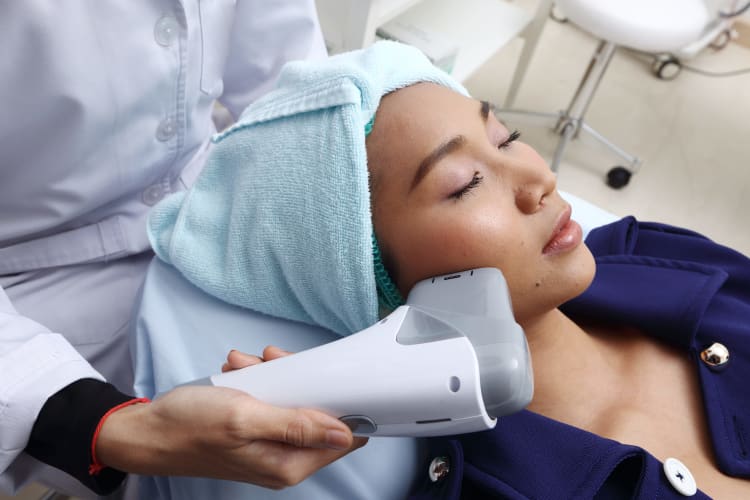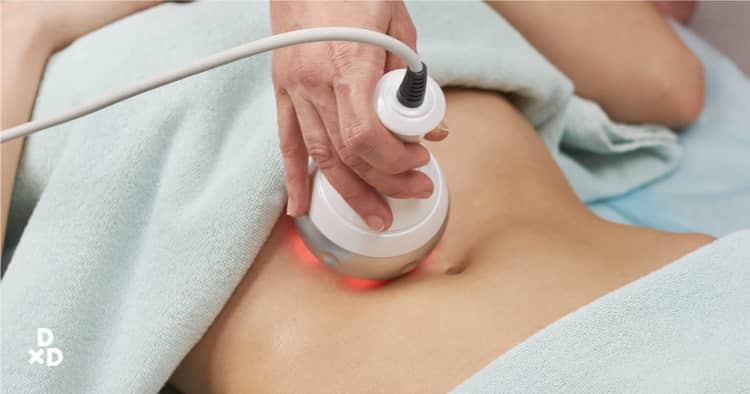Eye bags are generally a non-dangerous aesthetic concern for most people. However, you may feel that your eye bags give you a tired look constantly. Sometimes, they may even itch and be irritating, which leads people to look for ‘eye bag removal’ in Singapore.
But what if you are scared of a knife? Don’t worry. Whether your reasons for treatment are cosmetic or medical, there are non-surgical ways to treat your eye bags. Below, I talk about some of these non-surgical methods in this article.
What are eye bags?
Eye bags are actually sagging skin under your eyes. It commonly occurs as you age since the skin loses elasticity and fat padding. Because the skin under your eyes is thin, it is also easier to see the blood vessels beneath them. This results in darker skin and explains why your eye bags are darker with sagging skin. [1]
Are eye bags a sign of tiredness?
The usual cause of eye bags is aging. Eye bags can occur when:
- You do not have enough sleep.
- They usually occur because of genetics and skin tone.
- Eye bags can run in the family.
- If your skin tone is lighter your eye bags may look darker.
- Other causes include collagen loss and exposure to the sun.
Eye bags are normally just a cosmetic problem, although you should see a doctor if they begin to itch.
What are the types of eye bag removal?

Eye bag removal is called lower-eyelid blepharoplasty. You can either remove eye bags surgically or non-surgically. Some methods [2] include
- Surgical
- Non-surgical, which is divided into energy-based devices and injectables as shown in the table below.
Also read:
What is the difference between surgical and non-surgical permanent eye bag removal?
A Complete Guide To Laser And Skin Treatments In Singapore (2021)
Energy based devices
Injectables
HIFU (High Intensity Focused Ultrasound)
Mini-Threads
Contact/Microneedling RF (Radiofrequency)
Laser
In this article, I talk about non-surgical methods for eye bag removal.
How does each non-surgical treatment work?

All the non-surgical techniques affect either the skin around your eyes or the fat under it. Excess skin and/or fat could be removed, using techniques such as HIFU, or the skin tightened through techniques like Microneedling RF.
Read more: The only kind of bag you wouldn’t want: Top 5 non-invasive ways to get rid of Eyebags
1. HIFU
HIFU stands for ‘High-Intensity Focussed Ultrasound’. Originally used for the treatment of cancer, research has recently tried HIFU for aesthetic purposes. [3] In simple terms, HIFU uses ultrasound waves to penetrate deeper into the skin than previous non-surgical techniques, leading to better tissue tightening.
It does not cause major discomfort, although you may feel some heat or some slight pain lasting a few seconds at most. This is actually a good sign because it means that the process is working properly! There is no need for painkillers.
After the procedure, there may be some redness around your eyes that will settle in an hour. For the day, you will need to avoid laughing and chewing too much for the day, keeping your jaw stable. You may feel soreness for a couple of weeks, but this is normal.
2. Contact/Microneedling RF
Contact/Microneedling RF, where RF stands for Radiofrequency, is a procedure where electromagnetic waves at radio frequency are used to produce heat. This heat then travels to a layer of your skin called the hypodermis. This then causes an increase in blood flow through your blood vessels, resulting in the fat under your eyes being drained.
The areas where heat is applied will result in minor burns that will usually take up to 5-7 days to heal. Think of it as a sunburn. You may apply ointment to the burn area and will need to put on sunscreen for the next month. [4]
Also read: Are You Using Sunscreen Correctly? An Aesthetic Doctor Shares Her Best Advice
3. Laser
A Carbon Dioxide (CO2) Laser can be used for eye bag removal. This procedure is called lower-eyelid laser surgery. Cuts are made using a laser that makes the fat beneath the skin directly accessible. An advantage of this procedure is that you bleed less because the laser’s heat closes (cauterizes) the blood vessels. Other advantages include less risk of scarring, less discomfort, and faster recovery time.
4. Mini-Threads
Mini-Threads are used to lift and tighten sagging skin. [5] This treatment causes a noticeable, subtle lift in your skin. The procedure also activates the body’s healing system, causing collagen to flow to the treated areas. Collagen is an important protein in the aging process, providing structure to your skin and helping blood clot.
Mini-Thread procedures have almost no risk of scarring, severe bruising, or bleeding. You may experience skin irritation. The procedure is reversible and the threads can simply be removed. They are also less costly given how much simpler the procedure is compared to surgical treatments.
Related: The Ultimate Guide to Threadlift in Singapore (2021)
5. Fillers
Dermal fillers have become popular in lower-eyelid blepharoplasty. This involves the injection of Hyaluronic Acid Gel to smoothen out eye bag appearance. [6]
Also read: How to decide between fillers or eye bag removal to get rid of eye bags and dark eye circles?
In my clinic, we have a bladeless procedure that consists of a combination of energy-based treatments. This bladeless procedure is done in a single session which gives a trusting end result without going under the knife. This is great as it is hard to get a great change within a session and without it being surgical.
What are the possible risks and complications?

Just like every other medical treatment, there are possible and potential risks and complications that come along with it. In fact, the risks can be split into 2 types: expected and unexpected side effects. It is dependent on the technique that the doctor used.
Expected side effects
Energy-based devices
Most of the time when it comes to machines, you could expect mild swelling. The swelling will occur post-treatment as its energy causes hits the tissue, causing swelling and increased blood flow. For some machines, you may also expect bruising to occur. If skin resurfacing is needed, you may expect scabbing and peeling to occur.
Injectables
When it comes to injections, you may notice small traces of needle marks. However, it is possible to do an injectable treatment for the eye area and have almost no trace or downtime, apart from small needle holes. These tiny needle holes look similar to ant bites. Hence, patients must do detailed doctor selection. The risk of side effects may fall if you go for an experienced and well-trained doctor.
Unexpected side effects
Energy-based devices
Unexpected side effects may occur if your treatment is badly done or the technology used was inappropriate. You might get skin burns, thus scarring the eye bags.
In fact, it is possible but rare for excessive fat removal to happen. This will result in worsening your skin laxity. When the bulging fat is removed from the eye bag, it makes the skin loose.
Injectables
You may experience severe bruising, swelling, pain and lumpiness. These side effects commonly happen due to the doctor’s poor technique. When it comes to injectables, especially liquid fillers, there is a risk of skin necrosis or even loss of vision. However, these side effects are rare.
It is important to be wary of doctors who say that these treatments are risk-free. It is better to be forthcoming with the possible risks and that they have adequate measures to prevent them. Hence, do go for a doctor that is experienced in this field. From there, risks can be reduced and prevented. [7]
How much does eye bag removal cost?
Energy-based device treatments may start from $500 and rise to above $5000. Injectables may start from $400 and again rise to $5000.
Why is there a big range of eye bag removal prices?
Why is there a huge range in price? Well, there are many factors that affect the price of your treatment. For example,
- Type and brand of the equipment used
- Experience and Seniority of your doctor
- Intensity and length of treatment
- Severity and condition of your eye bags.
Generally the more severe your eye bags, the more it is going to cost to treat it. If you and your doctor agree on partial treatment, it will cost less than full treatment. More specialised equipment will also cost more since it has been made with the highest quality material to ensure effective results.
How effective is it? What are the factors that the result depends on?
The success and effectiveness of removing your eye bags depend on pre-operational planning and determining how much skin, muscle, and fat there is around your eyes. Other factors include how your eyelids are shaped. [8] A skilled doctor will measure how much each of these factors contributes to your eye bags and determine which treatment will suit you.
Of course, this also depends on what you are comfortable with. While all treatments are useful, there may be one or two that will be especially helpful for your eyes.
Surgical vs Non-Surgical, which is better for me?

In my experience, everybody has different wants and needs. Some patients who do not like surgery prefer non-surgical techniques, while others may conclude that surgical treatments may suit their needs better. There is no one right or wrong answer.
What is important is that you and your doctor agree on a treatment type that suits you and that you are comfortable with. Do consider the cost, advantages, and disadvantages of each treatment!
Also read: What is the best method for eye bag removal in Singapore?
What do I need to do before going for the removal?
There is nothing you need to do before non-surgical eye bag removal unless you have certain eye problems or issues. Consult with your doctor to be safe.
What should you do after the procedure?
While there is little downtime after eye bag removal, you may be required to stay in the clinic for a couple of hours until the anesthetic has worn off and there is no bleeding. After that, your doctor might tell you to do one of the following to reduce swelling or other side effects for about 2 days to a week.
- Apply a cold compress to the area
- Apply prescribed eye care products to prevent infection
- Limit exercising if at all possible
- Wear dark-tinted glasses
You can expect side effects to decrease significantly after 10-14 days. [9]
Can I do another session of non-surgical eye bag removal in my golden years?
Aging is a daily and progressive factor. When it comes to my bladeless procedure, it really depends on the severity of your eye bags. You may come back for the treatment once every few months for those with severe eye bags. Meanwhile, if you would like to get maintenance for them, you can choose to do this treatment once every few years.
How effective are commercial off-the-shelf eye bag treatment products? (Cream/masks)
While there have been some studies, such as this one, [10] suggesting products enhancing collagen production result in improved skin, data are limited. With the wide range of eye creams and masks, researchers can only do research on a select number of products. While there are no guarantees, if you want to buy an eye cream or mask, try and find scientific research before purchase.
Where should I go for an eye bag removal?
Doctors agree that eye bags are generally not a result of any serious medical problem. Most patients come for treatment to feel better about how they look. However, if your eye bags hurt or are itchy, do see a doctor. You may be referred to an eye specialist (opthalmologist), a plastic surgeon, or a doctor who specialises in plastic surgery of the eyes (oculoplastic surgeon).
Conclusion
You have many options when it comes to non-surgical eye bag removal, from injections to energetic techniques, including my own combined energy treatment technology. You don’t have to go under the knife. As you have seen, these treatments come with a wide range of advantages, including less downtime and predicted side effects.
Unexpected side effects normally occur because of poor technique by your doctor. One thing you can do is ask your doctor to describe what will happen during the procedure in a way that you understand so that you feel comfortable.












